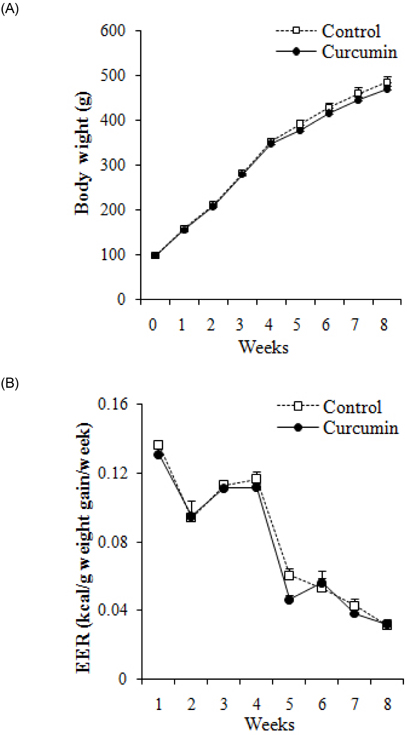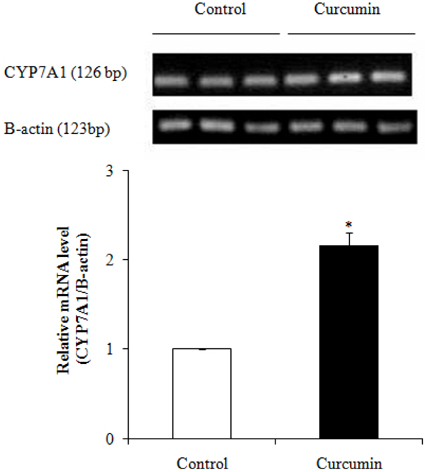Nutr Res Pract.
2010 Jun;4(3):191-195.
Hypocholesterolemic effects of curcumin via up-regulation of cholesterol 7a-hydroxylase in rats fed a high fat diet
- Affiliations
-
- 1Department of Nutritional Science and Food Management, Ewha Womans University, 11-1 Daehyn-dong, Seodaemun-gu, Seoul 120-750, Korea. yhmoon@ewha.ac.kr
Abstract
- There is an increasing interest in curcumin (Curcuma longa L.) as a cardiovascular disease (CVD) protective agent via decreased blood total cholesterol and low-density lipoprotein-cholesterol (LDL-cholesterol) level. The aim of this study was to investigate further the potential mechanism in the hypocholesterolemic effect of curcumin by measuring cholesterol 7a-hydroxylase (CYP7A1), a rate limiting enzyme in the biosynthesis of bile acid from cholesterol, at the mRNA level. Male Sprague-Dawley rats were fed a 45% high fat diet or same diet supplemented with curcumin (0.1% wt/wt) for 8 weeks. The curcumin diet significantly decreased serum triglyceride (TG) by 27%, total cholesterol (TC) by 33.8%, and LDL-cholesterol by 56%, respectively as compared to control group. The curcumin-supplemented diet also significantly lowered the atherogenic index (AI) by 48% as compared to control group. Hepatic TG level was significantly reduced by 41% in rats fed with curcumin-supplemented diet in comparison with control group (P < 0.05). Conversely, the curcumin diet significantly increased fecal TG and TC. The curcumin diet up-regulated hepatic CYP7A1 mRNA level by 2.16-fold, compared to control group p (P < 0.05). These findings suggested that the increases in the CYP7A1 gene expression may partially account for the hypocholesterolemic effect of curcumin.
Keyword
- Curcumin; cholesterol; CYP7A1; mRNA; rat
MeSH Terms
Figure
Reference
-
1. Rosamond W, Flegal K, Furie K, Go A, Greenlund K, Haase N, Hailpern SM, Ho M, Howard V, Kissela B, Kittner S, Lloyd-Jones D, McDermott M, Meigs J, Moy C, Nichol G, O'Donnell C, Roger V, Sorlie P, Steinberger J, Thom T, Wilson M, Hong Y. American Heart Association Statistics Committee and Stroke Statistics Subcommittee. Heart disease and stroke statistics-2008 update: a report from the American Heart Association Statistics Committee and Stroke Statistics Subcommittee. Circulation. 2008. 117:e25–e146.2. Assamann G, Cullen P, Jossa F, Lewis B, Macini M. Coronary heart disease: reducing the risk: the scientific background to primary and secondary prevention of coronary heart disease. Arterioscler Thromb Vasc Biol. 1999. 19:1819–1824.3. Zhang Z, Wang H, Jiao R, Peng C, Wong YM, Yeung VS, Huang Y, Chen ZY. Choosing hamsters but not rats as a model for studying plasma cholesterol-lowering activity of functional foods. Mol Nutr Food Res. 2009. 53:921–930.
Article4. Yang L, Kadowaki M. Effects of rice proteins from two cultivars, Koshihikari and Shunyo, on hepatic cholesterol secretion by isolated perfused livers of rats fed cholesterol-enriched diets. Ann Nutr Metab. 2009. 54:283–290.
Article5. Tucker KL. Dietary intake and coronary heart disease: a variety of nutrients and phytochemicals are important. Curr Treat Options Cardiovasc Med. 2004. 6:291–302.
Article6. Vincent HK, Bourguignon CM, Taylor AG. Relationship of the dietary phytochemical index to weight gain, oxidative stress and inflammation in overweight young adults. J Hum Nutr Diet. 2010. 23:20–29.
Article7. Soni KB, Kuttan R. Effect of oral curcumin administration on serum peroxides and cholesterol levels in human volunteers. Indian J Physiol Pharmacol. 1992. 36:273–275.8. Halliwell B. Dietary polyphenols: Good, bad, or indifferent for your health? Cardiovas Res. 2007. 73:341–347.
Article9. Araújo CC, Leon LL. Biological activities of Curcuma longa L. Mem Inst Oswaldo Cruz. 2001. 96:723–728.
Article10. Asai A, Miyazawa T. Dietary curcuminoids prevent high-fat diet-induced lipid accumulation in rat liver and epididymal adipose tissue. J Nutr. 2001. 131:2932–2935.
Article11. Beynen AC, Visser JJ, Schouten JA. Inhibitory effect on lithogenesis by ingestion of a Curcuma mixture (Temoe Lawak Singer). Journal of Food Science and Technology. 1987. 24:253–256.12. Hiserod R, Hartman TG, Ho CT, Rosen RT. Characterization of powdered turmeric by liquid chromatography-mass spectrometry and gas chromatography-mass spectrometry. J Chromatogr. 1996. 740:51–63.
Article13. Manjunatha H, Srinivasan K. Hypolipidemic and antioxidant effects of curcumin and capsaicin in high-fat-fed rats. Can J Physiol Pharmacol. 2007. 85:588–596.
Article14. Asai A, Miyazawa T. Dietary curcuminoids prevent high-fat diet-induced lipid accumulation in rat liver and epididymal adipose tissue. J Nutr. 2001. 131:2932–2935.
Article15. Babu PS, Srinivasan K. Hypolipidemic action of curcumin, the active principle of turmeric (Curcuma longa) in streptozotocin induced diabetic rats. Mol Cell Biochem. 1997. 166:169–175.16. National Institute of Health. Guide for the care and use of laboratory animals. 1996. Washington DC: National Academic Press;21–55.17. Sale FO, Marchesini S, Fishman PH, Berra B. A sensitive enzymatic assay for determination of cholesterol in lipid extracts. Anal Biochem. 1984. 142:347–350.
Article18. Friedewald WT, Levey RI, Fredrickson DS. Estimation of the concentration of low-density lipoprotein cholesterol in plasma, without use of the preparative ultracentrifuge. Clin Chem. 1972. 18:499–502.
Article19. Rosenfeld L. Lipoprotein analysis. Early methods in the diagnosis of atherosclerosis. Arch Pathol Lab Med. 1989. 113:1101–1110.20. Bligh EG, Dyer WJ. A rapid method of total lipid extraction and purification. Can J Physiol Pharmacol. 1959. 37:911–917.
Article21. Rozen S, Skaletsky HJ. Krawetz S, Misener S, editors. Primer3 on the WWW for general users and for biologist programmers. Bioinformatics methods and protocols: Methods in molecular biology. 2000. New Jersey: Humana Press;365–386.
Article22. Ejaz A, Wu D, Kwan P, Meydani M. Curcumin inhibits adipogenesis in 3T3-L1 adipocytes and angiogenesis and obesity in C57/BL Mice. J Nutr. 2009. 139:919–925.
Article23. Baum L, Cheung SK, Mok VC, Lam LC, Leung VP, Hui E, Ng CC, Chow M, Ho PC, Lam S, Woo J, Chiu HF, Goggins W, Zee B, Wong A, Mok H, Cheng WK, Fong C, Lee JS, Chan MH, Szeto SS, Lui VW, Tsoh J, Kwok TC, Chan IH, Lam CW. Curcumin effects on blood lipid profile in a 6-month human study. Pharmacol Res. 2007. 56:509–514.
Article24. Thimmayamma BVS, Rau P, Radhaiah G. Use of spices and condiments in the dietaries of urban and rural families. Indian J Nurt Diet. 1983. 20:153–162.25. Manjunatha H, Srinivasan K. Protective effect of dietary curcumin and capsaicin on induced oxidation of low-density lipoprotein, iron-induced hepatotoxicity and carrageenan-induced inflammation in experimental rats. FEBS J. 2006. 273:4528–4537.
Article26. Rao DS, Sekhara NC, Satyanarayana MN, Srinivasan M. Effect of curcumin on serum and liver cholesterol levels in the rat. J Nutr. 1970. 100:1307–1316.
Article27. Srinivasan K, Sambaiah K. The effect of spices on cholesterol 7 alpha-hydroxylase activity and on serum and hepatic cholesterol levels in the rat. Int J Vitam Nutr Res. 1991. 61:364–369.28. Kuwabara T, Han KH, Hashimoto N, Yamauchi H, Shimada K, Sekikawa M, Fukushima M. Tartary buckwheat sprout powder lowers plasma cholesterol level in rats. J Nutr Sci Vitaminol (Tokyo). 2007. 53:501–507.
Article29. Peschel D, Koerting R, Nass N. Curcumin induces changes in expression of genes involved in cholesterol homeostasis. J Nutr Biochem. 2007. 18:113–119.
Article
- Full Text Links
- Actions
-
Cited
- CITED
-
- Close
- Share
- Similar articles
-
- Effects of Liquid Culture of Coriolus Versicolor on Lipid Metabolism and Enzyme Activities in Rats Fed High Fat Diet
- Effects of Liquid Culture of Agaricus blazei Murill on Lipid Metabolism and Enzyme Activities in Rats Fed High Fat Diet
- Dietary chitosan enhances hepatic CYP7A1 activity and reduces plasma and liver cholesterol concentrations in diet-induced hypercholesterolemia in rats
- Effects of Soyoligosaccharide on Lipid Metabolism in Rats Fed the High Fat or Low Fat Diet
- Effects of taurine on plasma and liver lipids, erythrocyte ouabain sensitive Na efflux and platelet aggregation in Sprague Dawley rats




